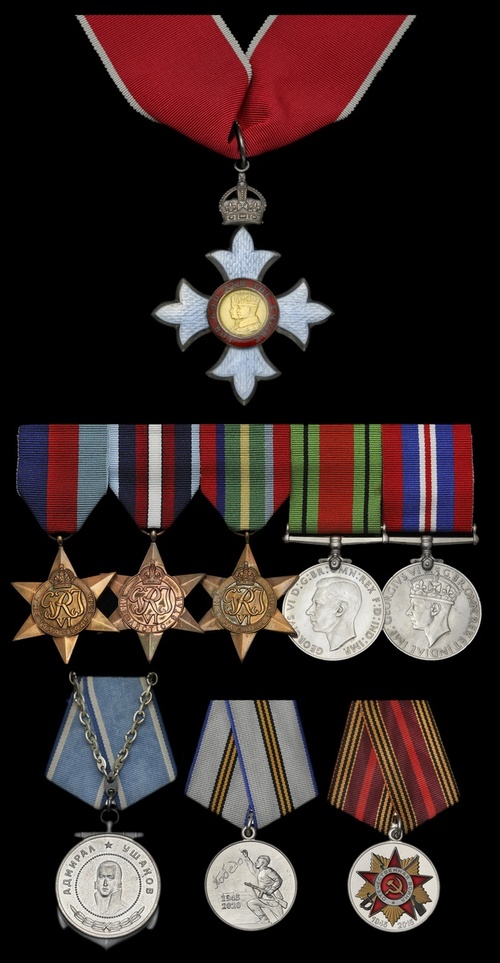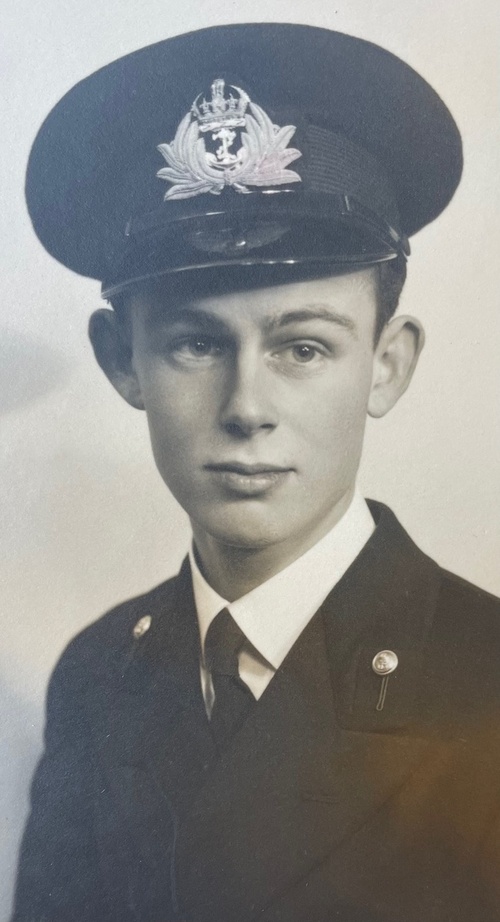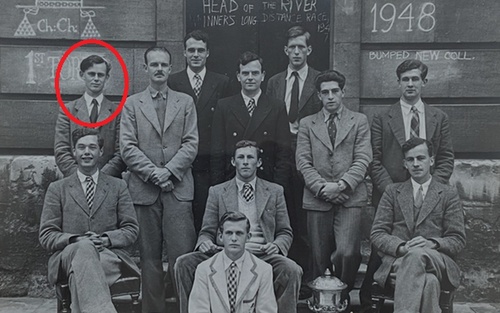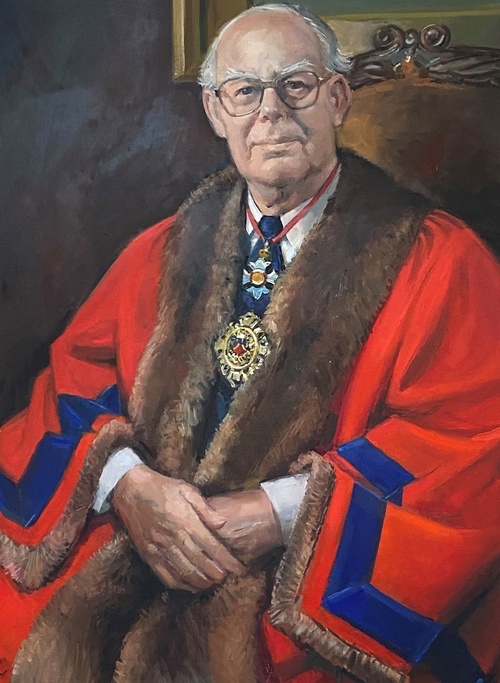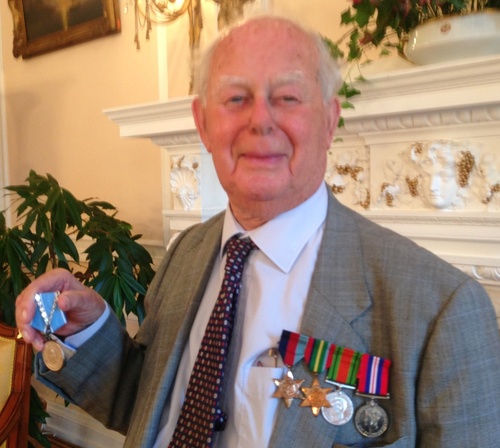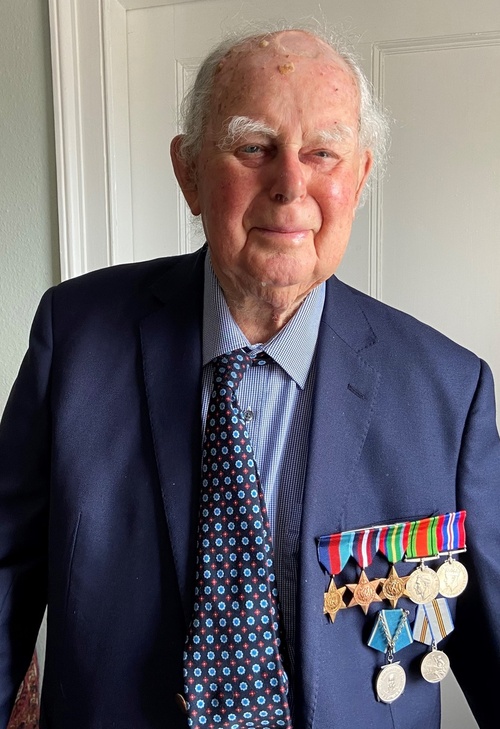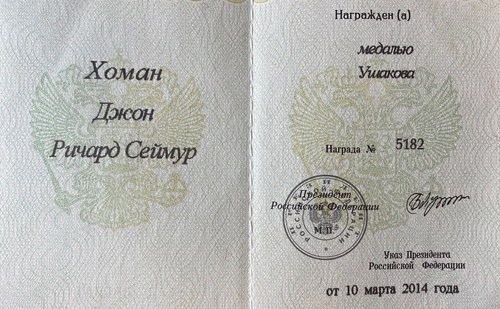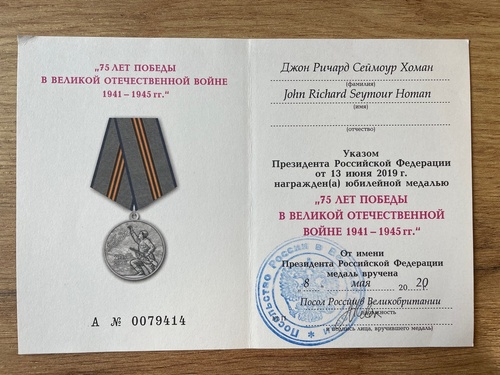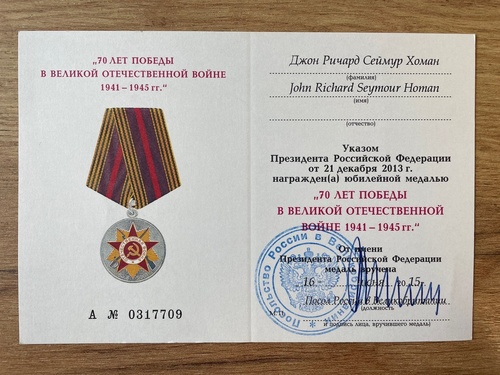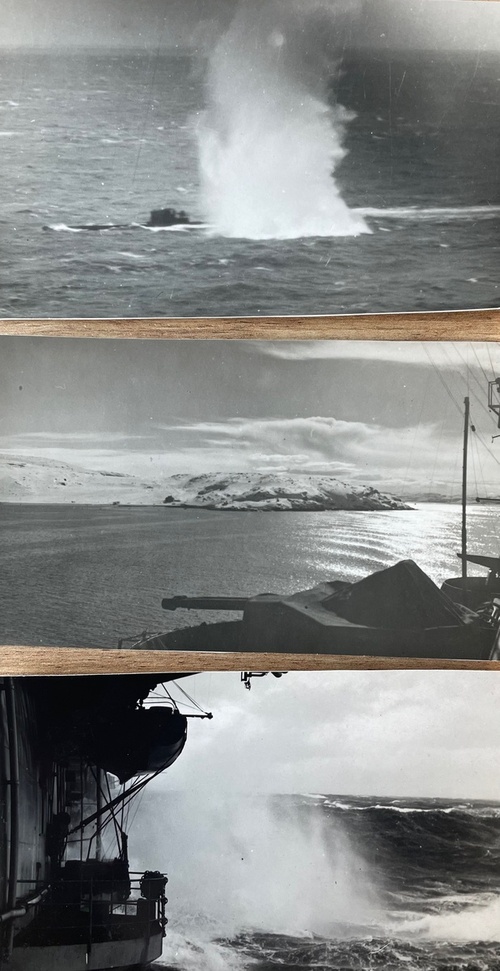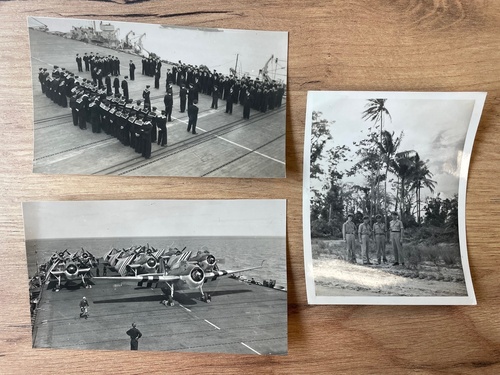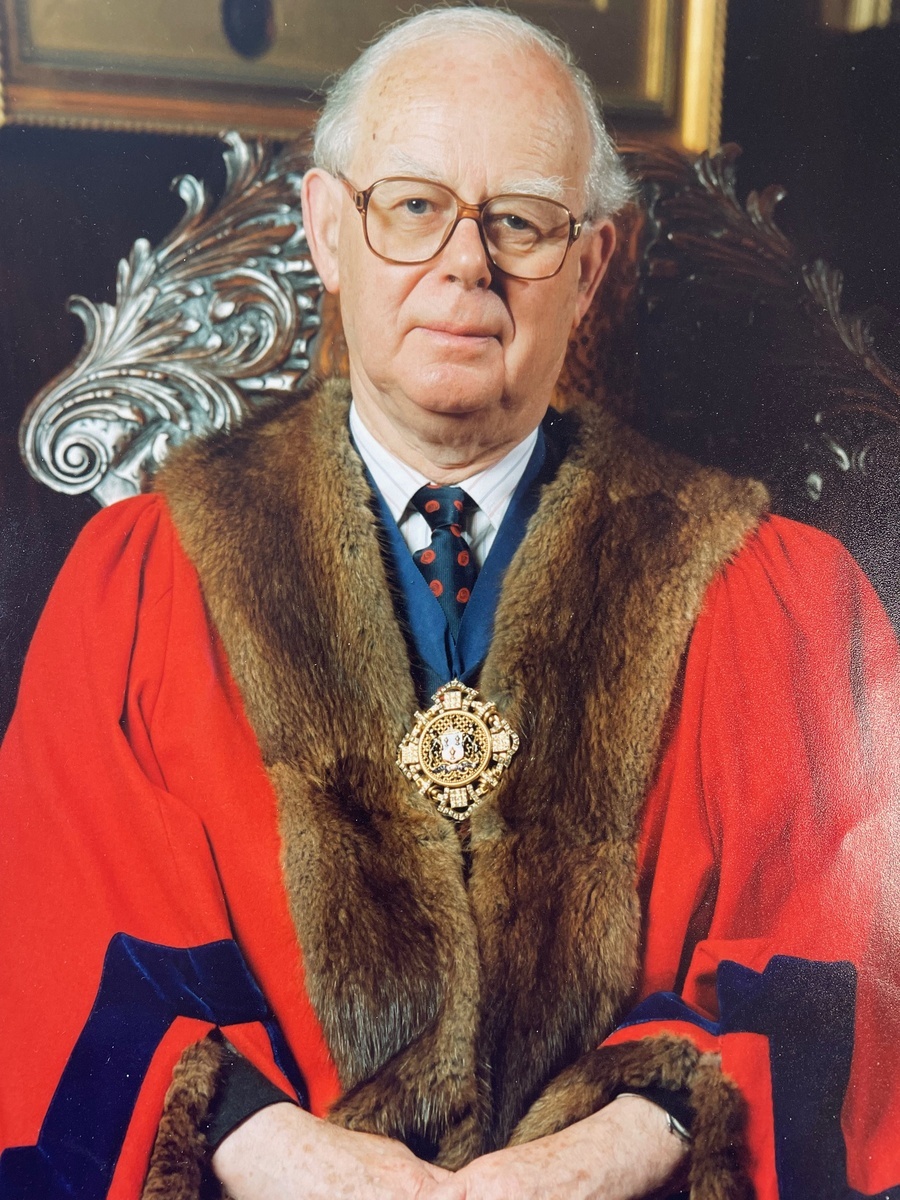Auction: 25001 - Orders, Decorations and Medals
Lot: 305
Sold by Order of a Direct Descendant
The very complete 1985 C.B.E. and 'Arctic Convoys' group of nine awarded to Sub Lieutenant J. R. S. Homan, Royal Navy, who served on the aircraft carrier H.M.S. Tracker, latterly Industrial Director of the National Economic Development Office
The Most Excellent Order of the British Empire, Civil Division, 2nd Type, Commander's (C.B.E.) neck Badge, silver and silver-gilt, with full and miniature neck ribbons, in case of issue; 1939-45 Star; Arctic Star, with its named box of issue; Pacific Star; Defence and War Medals 1939-45, these five mounted as worn; together with Russia, Soviet Union, Ushakov Medal, reverse officially numbered '5182' with accompanying named certificate in case of issue; Russia, 70th and 75th Anniversary of the Great Patriotic War Medals, with accompanying named award certificates, good very fine (9)
C.B.E. London Gazette 15 June 1985.
John Richard Seymour Homan - or "Dick" to his friends and comrades - was born at Burley, Hampshire on 7 January 1925, the son of Captain Charles Edward Homan. He was initially educated at a pre-prep school in London then to St. Wilfrid's, Seaford in Sussex and in 1938 he attended Radley College before entering the Royal Navy in 1943 as a Midshipman. Classified as an 'Executive Special' he was posted to the Admiralty in London working in the personnel department. Requesting active service, he was posted to Tracker, an aircraft carrier, where he was given the job of plotting U-boat locations.
Tracker served as an escort during 1943-1944 for North Atlantic and Arctic convoys. She originally carried Swordfish torpedo-bombers and Seafire fighters of No. 816 (Naval Air) Squadron, in January 1944, switching to the Grumman Avengers and Grumman Wildcats of No. 846 (Naval Air) Squadron. In April 1944, her aircraft, together with those from Activity were responsible for the sinking of the U-288 east of Bear Island, during convoy JW-58.
On 10 June 1944, while part of the antisubmarine screen of the Western Approaches Command for the D-Day landings, she collided with a River-class frigate of the Royal Canadian Navy, Teme, causing damage to both ships. Tracker continued operations despite stove-in bows until 12 June 1944. Thereafter, she was repaired and partially refitted in Liverpool, until 7 September 1944. On 8 December 1944, the ship sailed to the United States to be used as an aircraft transport and spent the remainder of the war ferrying aircraft and personnel in the Pacific.
Homan recounted her tenth and last convoy patrol to Murmansk in October 1944, in an interview he gave in 2020:
'We escorted a Russian convoy to Murmansk. The Germans could by this time no longer use the west coast of France because of the Allied invasion, and so many U boats were sent to the Arctic. We were in a powerful convoy with three aircraft carriers, 25 other warships and about 28 merchant ships. Many of the merchant ships came from the U.S.A., carrying food and military equipment for the Russians, everything from planes, tanks, guns and ammunition down to boots.
Despite the size of the convoy the U boats didn't know we were there until we got to the north of Norway, so the first part was peaceful. I say peaceful but, at that time of year, it was dark most of the day and pretty stormy and very cold. Twilight was about 1pm. We would fall back from the convoy to fly off our aircraft. The bravery of those pilots was incredible.
Many were in exposed open cockpits and would have to take off from their carrier surging up and down in a rough sea. One of our aircraft got lost and had to break radio silence. That alerted Berlin who sent a wolf pack of U boats after us. We were heading due east and Berlin anticipated, quite correctly, that we would change our course to southeast, which is where the U boats went. However, London picked up Berlin's signal and instructed us to continue travelling east. The U boats missed us. It was not a complete triumph.
Sending our aircraft after the U boats we were equipped with some wonderful new secret weapon, which unfortunately bounced harmlessly off the conning tower. I remember one disappointed pilot coming back and saying, "there goes my DSC". It was quite unusual that the convoy completed its journey there and back without loss of a single ship. I didn't realise until after the war that the Admiralty instruction to change from our original course was based on information from Bletchley. We had been unaware of Bletchley's existence.'
U.S. Navy loan: December 1944 - July 1945
Tracker left Greenock on 8 December 1944 and reached New York in time for Christmas, she was to stay there until New Year's Eve when she put to sea headed for the Panama Canal and reached San Diego on 17 January 1945. Here the ship's company received the same levels of hospitality they had enjoyed at Portland while the ship was being built. Books, magazines, music, sports kit, and more were donated to the ship for the men's 'comforts' by the Red Cross and U.S. Armed Forces Institute.
After a week in San Diego, Tracker moved to San Pedro for the next five days, and opportunity was taken for the crew to experience Hollywood and film stars 'popped in' to visit the ship. By the end of January, she was full of aircraft and passengers bound for Hawaii and American bases in the Pacific. Her first voyage in the transport role took her to the Admiralty Isles and New Guinea in then back in San Diego, arriving back there on 20 March, a round trip of 13,424 miles taking two months. On the return trips Tracker carried U.S. personnel and casualties back to Pearl Harbour.
Her second transport run was to Guam and Saipan in the Mariana Islands in April, during this trip the news of President Roosevelt's death reached the ship and her passengers, a memorial service was held on board. V.E. day, 8 May 8, was celebrated on the last leg from Hawaii three days out from San Diego and the end of a 13,020-mile trip.
Tracker's third trip took her to the Marshal Islands and back, a shorter, 10,000 miles haul from 12 June-8 July. This was her last operation for the U.S. Navy, she had ferried 300 aircraft and 100 passengers in her three voyages and had steamed 36,000 miles across the Pacific. After storing ship Tracker was to proceed back to Britain, leaving San Diego on 13 Friday having exchanged a few crew members with her sister C.V.E. Atheling, also on transport duties; those men on Atheling who qualified for release under the recently announced 'Age & Service Release Scheme', with Tracker's 'newbies' filling their billets. She reached Norfolk, Virginia on 27 July and New York three days after.
Homeward bound
This was to be Tracker's last east bound crossing, carrying on board American wives of British Naval personnel, evacuated children, and over a hundred members of the Fleet Air Arm from the Air Station in New Brunswick which was closing down. She made Greenock on 9 August and disembarked her passengers; work began almost immediately de-storing Tracker in preparation for her final voyage, her return to the U.S. Navy, her service with the Royal Navy ending.
The war over, Homan read classics at Christ Church College, Oxford from 1946 graduating with a degree in philosophy, politics and economics. A keen oarsman during his time at the House was part of the team who won Head of the River in 1948. He was a lifelong member of Christ Church Boat Club.
Homan joined the I.C.I. with whom he spent the bulk of his working career. He married The Hon. Mary Graham Buckley, daughter of Bryan Burton Buckley, 2nd Baron Wrenbury and Helen Malise Graham, on 8 April 1961.
Leaving I.C.I., he became the Industrial Director at the National Economic Development Office which was the secretariat of the National Economic Development Council. Its function was to service the N.E.D.C., to conduct the N.E.D.C.'s programmes of research and investigation, and to produce reports on its findings. He was duly rewarded with the C.B.E. in 1985.
"Dick" Homan gave a fascinating interview about his life to the Albury Parish News in July 2020, issue number 364, https://www.alburychurches.org/wp-content/uploads/2021/04/July-2020-view.pdf
He died on 6 October 2023 at the remarkable age of 98; sold together with original glazed and framed C.B.E. Warrant, a quantity of related photographs and two notebooks of events written by Homan during his war service.
Subject to 20% VAT on Buyer’s Premium. For more information please view Terms and Conditions for Buyers.
Estimate
£1,000 to £1,400
Starting price
£850

